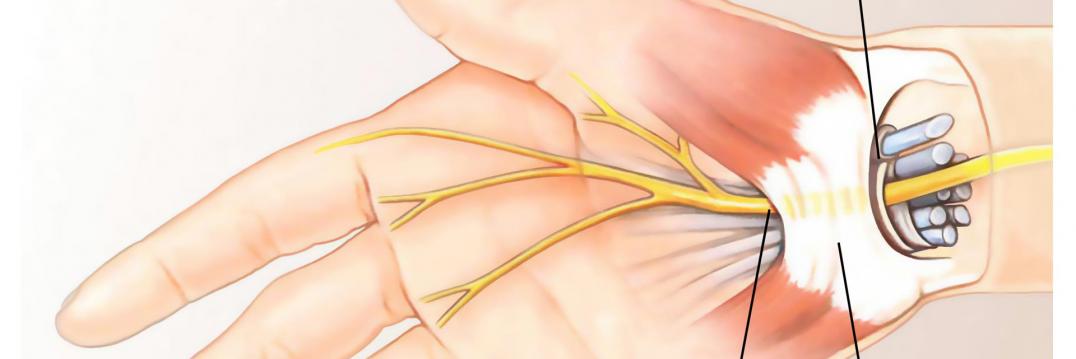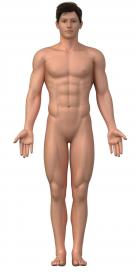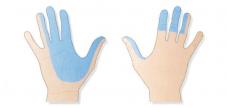You are here: Home » Diagnosis » Nerval Kompression
nerval compression
Carpal tunnel syndrome
Carpal tunnel syndrome
The symptoms are mostly obvious but anyways we initiate a measurement of the nerve conduction velocity which we can also perform at our medical office.
Nerve: Nervus medianus
Location of the nerval compression: inner part of the wrist
Character: dragging pain which mostly appears in the early morning hours. The pain increases with time and can be triggered eg. by prolonged computer work
N. Ulnaris Syndrome, Kubitaltunnelsyndrom
N. Ulnaris Syndrome
Nerve: Nervus ulnaris
Location of the nerval compression: elbow at the sulcus ulnaris
Localisation: small and annular finger
Character: dragging pain, prickling, numbness. Can be triggered by prolonged computer works or reading a book. If the damage is in an advanced stage the patient experiences a inability to hold things or to open a bottle.
Loge de Guyon Syndrom
Nerve: Nervus ulnaris
Location of the nerval compression: inner part of the wrist
Localisation: small and annular finger
Character: dragging or prickling. Can be triggered by biking or deviating the hand. In an advanced stage the spreading of the fingers can be limited.
Meralgia parästhetica nocturna
This syndrome is characterized by prickling and pain during the night
Nerve: Nervus cutaneous femoris lateralis
Location of the nerval compression: Inguinal ligament. The nerve can be compromised when the patient stands or sits as well as due to obesity or tight clothes.
Localisation: Crest and exterior part of the thigh.
Character: dragging, prickling and numbness. The discomfort can be triggered by different body positions: standing, sitting, obesity or tight clothes.
Piriformis Syndrome
Nerve: Nervus ischiadicus
Loaction of the nerval compression: gluteal exit of the nerve. Here exists a close anatomical relation between the nerve and the musculus piriformis which connects the femoral head to the sacral bone. If the muscle shortens or thickens the nerve can be compressed.
Localisation: dragging pain which radiates into the feet.
Character: dragging, sometimes prickling. The pain is similar to the pain which patients experience who suffer from a slipped disk. It can be triggered by long sitting, an arthrosis of the hip or overload.
Therapy: local massage and physiotherapy. An ultrasound guided blocking can bring up to 80% success. We suggest to avoid an operational intervention.
Nerve: Nervus peroneus
Nerve: Nervus peroneus (branches out of the nervus ischiadicus and supplies the calf
Location of the nerval compression: head of the fibula where the nerve is palpable
Localisation: shank, big toe, symptoms are similar to a slipped disk at the level L4/5
Character: Paralysis of lifting the feet, dragging pain which radiates into the big toe, numbness, prickling
Trigger: Could appear due to wrong position of the patient during an operation. After a long car ride or long kneeling
Tarsaltunnel-Syndrom
Nerve: terminal branches of the nervus tibialis
Loaction of the nerval compression: medial ankle, the tarsal tunnel is located between the medial ankle and the calcaneal tendon (Achilles tendon). The Nervus tibialis seperates into the Nervus plantaris medialis and the Nervus lateralis at the level of the tarsal tunnel. The nerves have sensory branches which supply the bottom of the foot as well as the toes.
Localisation: medial ankle, radiations into the heel and the bottom of the feet
Character: burning pain as well as loss of sensation or hypersensitivity of the bottom of the feet. The pain can increase during the night or after a long period of sitting or walking.
Morton Neuralgie
Nerve: Nervi plantares of the Nervus tibialis
Location of the nerval compression: between the metatarsal bones. Due to a chronic stimulisation of this nerves a Neurom can develop which can be seen by a magnet resonance imaging.
Localisation: medial forefoot
Character: zapping pain which aggravates during walking. The cause can be too tight shoes or high heels. The pain can be triggered by pressure between the toes.
Trigeminusneuralgie und andere Hirnnerven
Post-Leistenhernien-Syndrom
Post hernia syndrome
Nerve: Nervus ilioinguinalis, N. genitofemoralis, N. iliohypogastricus, N. cutaneous femoris lateralis
Location of the nerval compression: In the area of the scar after an operation of an inguinal hernia, appendix operation or intestinal operation.
Localisation: depending on the nerve: crest, testis, labia, lateral part of the thigh
Character: dragging pain, prickling, sensation disorders, the symptoms may increase during walking or standing
Causes:
Some nerves run through anatomical narrowings, which can bear pressure on the corresponding nerve if they narrow in a higher degree. A trigeminal neuralgia for example is caused by a blood vessel which pressures the nerve. Compared to a nerve damage this chronic pressure can lead to the same symptoms.
Further causes:
chronic pressure
bone fractures
sprain
tumors
overload
The symptomatics is very unique in most of the cases. Anyways we would like to perform a measurement of the transmission velocity of the nerve which can be made either at a neurologic office or at our medical office.
During this examination there will be a validation of the motor and sensory functions of the nerve. The so called Hoffmann- Tinelsche sign is a electrical discomfort when the physician touches the nerve superficially.
Due to a compression syndrome it is highly recommended to perform an operational intervention because it leads to a significant improvement in 90 % of cases. Other symptoms can be treated conservatively
If the discomfort is not so severe the main way of treatment is to stabilize with a cuff. A very good short time treatment is a cortisone syringe.
When you suffer from restless sleep due to the compression of the nerve, muscle weakness or permanent numbness it is recommended to perform an operational denudation of the nerve. The operation can be performed at the ambulance and takes about 5- 15 min.





